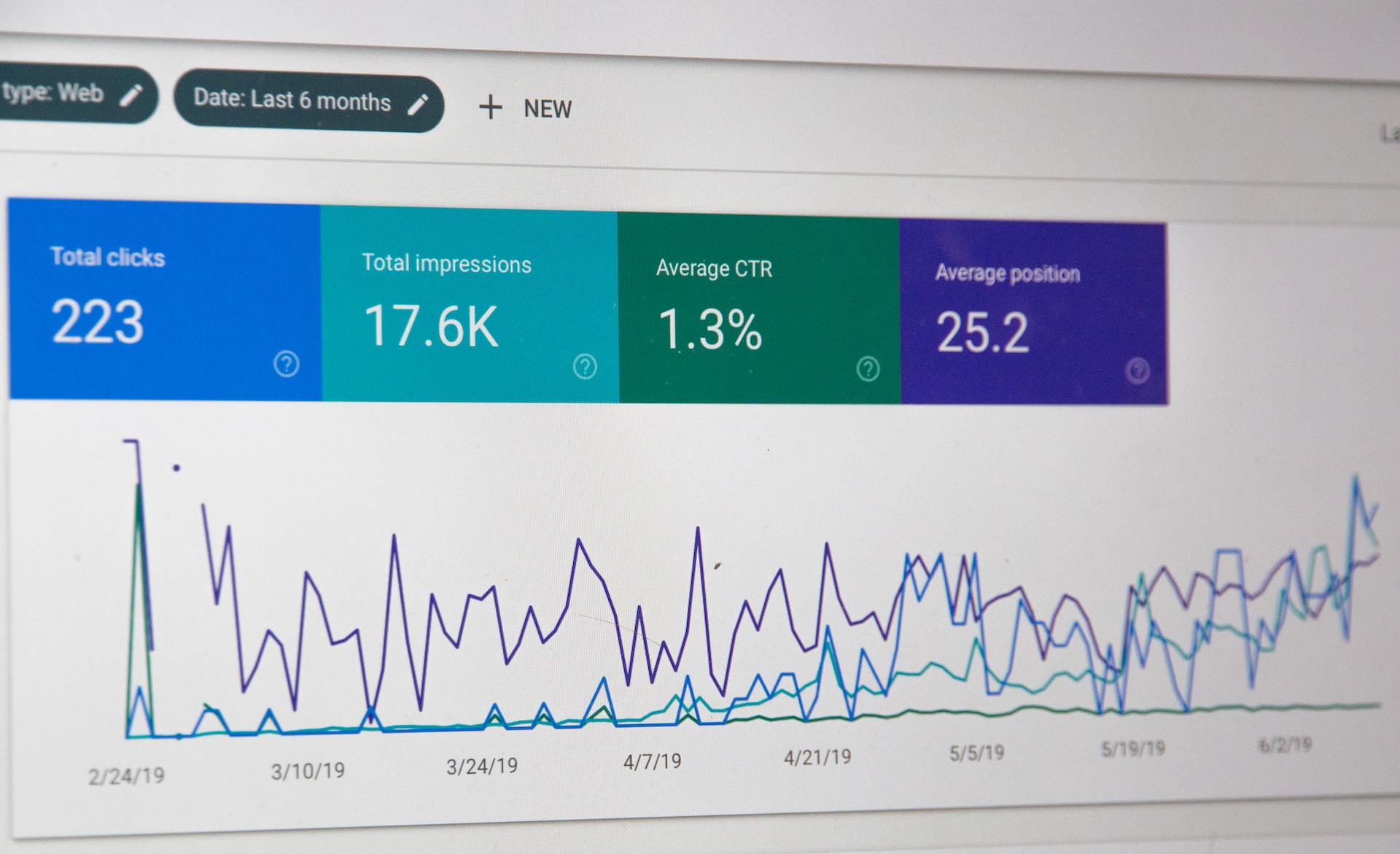As a marketer, you know that the landscape is constantly changing, and finding new ways to drive growth is essential for the success of any business. That's where growth marketing comes in. But what exactly is growth marketing?
In this guide, you’ll learn:
The key principles of growth marketing and how it differs from traditional marketing
Strategies for identifying and optimizing your key growth channels
Real-world examples of successful growth marketing campaigns, and
The template, tools, and metrics you need to create your own success story
Let’s get started.
Definition of growth marketing
Growth marketing is a dynamic, data-driven approach to marketing that prioritizes measurable results such as user acquisition, revenue growth,
brand loyalty, and recognition. It involves constantly experimenting with various marketing strategies and tactics to meet the ever-changing needs of customers.
For this reason, growth marketers use a full-funnel mindset to engage with customers at every stage of their journey and validate their new ideas through experiments before committing marketing resources.
All this follows five core components or principles of growth marketing:
Rapid iteration: Always test marketing strategies to find the most effective approach. Use data and insights to make quick, informed decisions for adjusting growth campaigns.
Experimentation: Run multiple tests to identify what works best for your audience. It’s a constant process of refining and optimizing to unlock better results.
Multi-channel marketing: Customers interact with brands across multiple channels, from social media to email to offline channels. As a growth marketer, use a variety of channels to reach customers where they are with consistent messaging across all touchpoints.
Customer and data feedback: Use customer feedback to understand pain points and preferences, and data to identify trends and measure the success of your campaigns.
What growth marketing isn’t
To paint a more vivid picture of growth marketing, let’s compare it to digital marketing, traditional marketing, and growth hacking.
Growth marketing vs. digital marketing
Digital marketing is a traditional approach to raising awareness and generating leads online. These leads are then handed off to sales. Hence, it is more of a top-of-funnel-focused marketing. Growth marketing focuses on the entire customer journey, from acquiring new customers to retaining existing ones (full-funnel approach), often collaborating with sales and customer success teams.
While both approaches use email marketing, PPC advertising, content, SEO, social media, marketing automation, and other strategies, growth marketing operates differently. It is like a
culture of data-driven marketing powered by a
growth mindset.
Growth marketing teams will use the same strategies as digital marketing teams but will also test them, gather data, and conduct analysis to find the straightest path to higher levels of growth.
Growth marketing vs. traditional marketing
While growth marketing and traditional marketing have some overlapping tactics, there are some key differences between the two approaches. Traditional marketing is often focused on one-off campaigns or tactics, such as television commercials or print ads. It's typically more
top-of-funnel, focused on
brand exposure, and less focused on data and analytics.
On the other hand, growth marketing is proactive and continuous. It's focused on finding and exploiting growth opportunities over the long term and relies heavily on data and analytics to inform decision-making and optimize efforts.
Growth marketers are also more likely to experiment and iterate in order to find what works best for their business. Growth marketing takes place at all stages of the
marketing conversion funnel, from
brand marketing to customer retention.
Growth marketing vs. growth hacking
Growth hacking is focused on achieving rapid growth through hands-on tactics and experimentation, often with a specific acquisition goal in mind.
Sean Ellis coined the term “growth hacking” in 2010 when he was looking to hire a marketer to help grow his user base as fast as possible.
It is often associated with startups and early-stage companies, as it is a way to quickly achieve results with limited resources. As a growth hacker, Sean ignited breakout growth at Dropbox, Eventbrite, and LogMeIn. Growth hacking typically involves using data-driven experiments to optimize conversion rates, increase user engagement, and drive traffic to a website or product.
On the other hand, growth marketing takes a more holistic approach to achieving long-term growth through a full-funnel strategy.
What does a growth marketer do?
A growth marketer's primary goal is to identify and exploit growth opportunities for their business. This might involve anything from finding new customer segments to targeting to improving the customer experience. A growth marketer's responsibilities might include:
Conducting market research to identify growth opportunities
Developing light-weight experiments to test assumptions
Collaborating with other teams, such as product and engineering, to identify and implement growth opportunities within their product
Communicating growth strategy and results with the rest of the organization
A growth marketing manager will often have to manage specialists in a growth marketing team. So, some leadership skills are needed there as well.
Here’s an example of the responsibilities and qualifications required in a typical growth marketer job description:
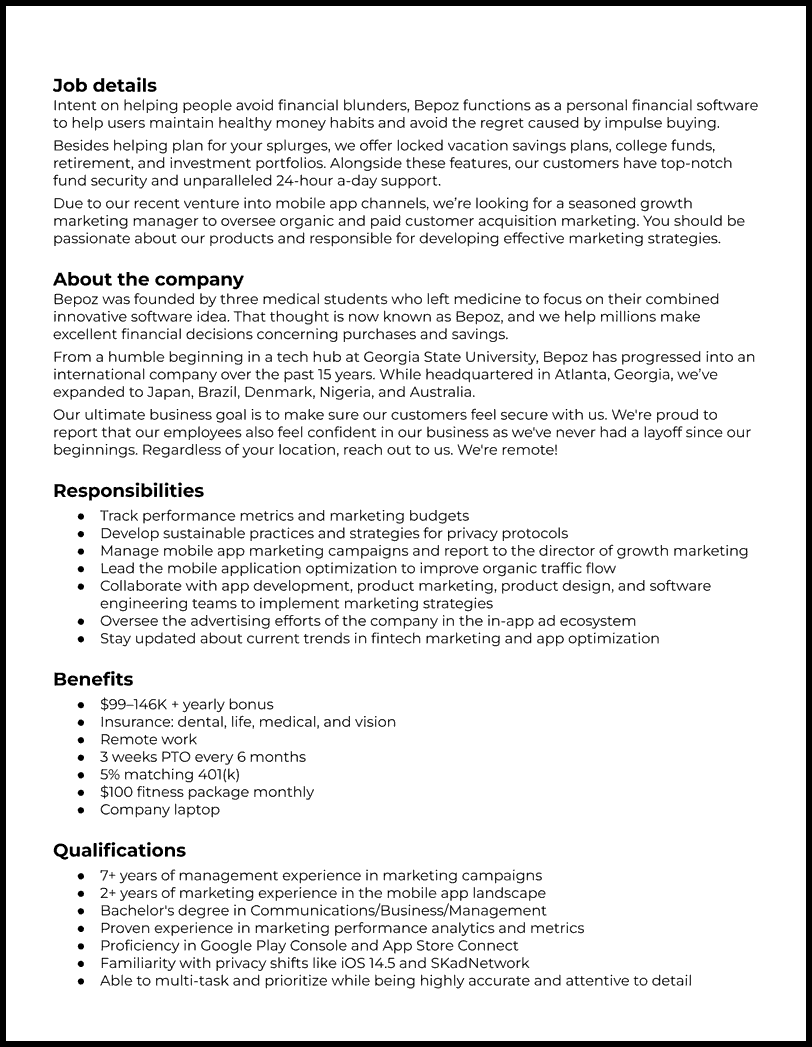
What are growth marketing frameworks?
Growth marketing frameworks are structured, repeatable steps marketers follow to effectively achieve sustainable and profitable
business growth with marketing. Growth marketers use them as a foundation for creating a growth marketing strategy. Let’s look at three notable frameworks.
1. AAARRR framework
The AAARRR framework, also known as the Pirate Funnel (because it sounds like a pirate yell), breaks a business down into six steps or metrics. The six metrics are:
Awareness: How many people know about your brand or product?
Acquisition: How many people visit your website or engage with your service?
Activation: How many people take the first step towards becoming a customer, such as creating an account or installing an app?
Retention: How many people return to experience your product again and again?
Revenue: How many people start paying for your product, and how much do they pay?
Referral: How many people recommend your company to others?
This model can be interpreted differently for various businesses. It is only a foundation for designing a unique strategy. Further breaking down each step:
Awareness
Here, customers discover your company. This is where you learn the best marketing channels to reach your target audience, what platforms they engage with the most, and how to spread word-of-mouth
virality. You’d be most concerned about attention metrics here, such as click-through rates (CTR), bounce rates, average watch time, impressions, etc.
Acquisition
The second step is about making potential customers engage with your products or services. It involves finding the right customers instead of trying to acquire as many as possible. Companies must understand their customers' needs and preferences to provide compelling solutions.
Metrics to measure in this phase include the cost per acquisition, conversion rate, and the number of new sign-ups.
Activation
This step involves making customers take the first step towards using a company's product or service. It could be signing up for a free trial or downloading an app.
The challenge here is creating an aha! moment to firmly onboard them as a customer. Metrics to measure in this phase include the user activation rate, time to first value, and feature adoption rate.
Retention
The fourth step is about ensuring that customers come back for more. You must provide an excellent user experience, constantly improve your product, and offer ongoing support to retain customers. This is where metrics like churn rate, customer lifetime value, and the number of active users matter the most.
Revenue
This step involves converting customers into paying users. You need a defined pricing strategy and a product worth paying for to win here. Metrics to measure in this phase include the average revenue per user and customer acquisition cost.
Referral
The last step is about encouraging customers to recommend your product or service to others in their network. You can trigger this by offering incentives via a
referral program. Or you can create a viral loop to encourage word-of-mouth marketing. Crucial metrics here include the Net Promoter Score (NPS), referral rate, and customer satisfaction.
2. G.R.O.W.S. process
The G.R.O.W.S. process is a widely used 5-step loop for running marketing experiments. It is popular among growth marketers and growth hackers.
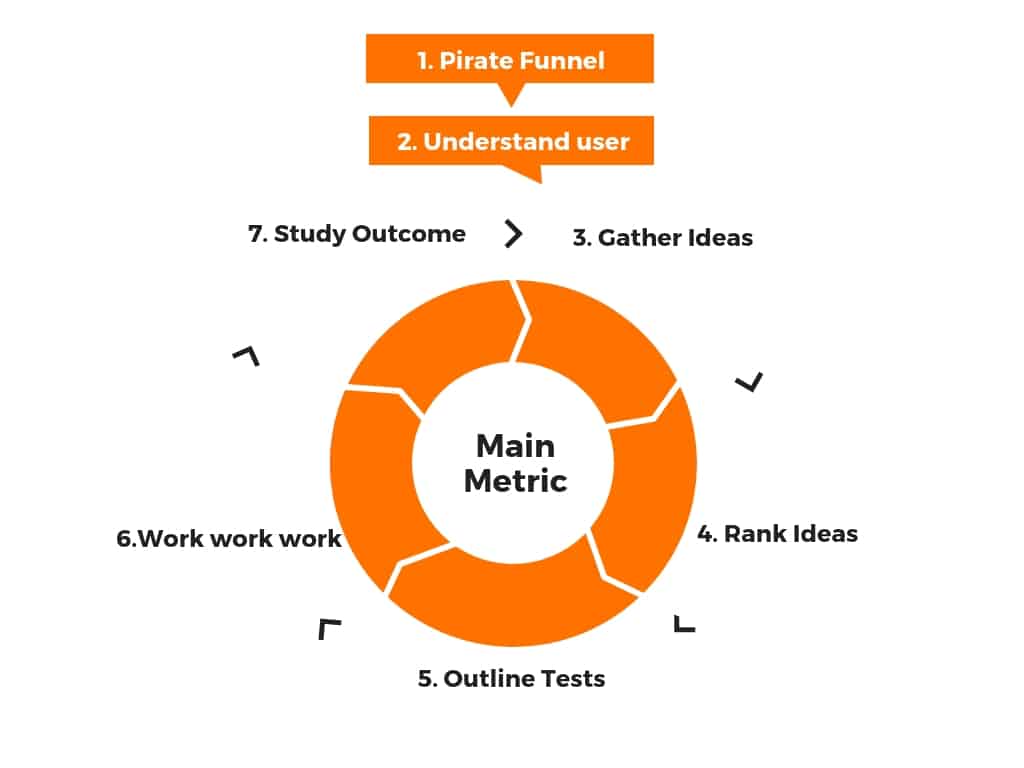
The steps include:
Gather ideas: Leverage the data collected from the Pirate Funnel to understand what the business needs to do and to identify the ‘OMTM’ or ‘One Metric That Matters’ to focus on.
Rank ideas: Start from best to worst using frameworks like B.R.A.S.S., P.I.E., and I.C.E. The
B.R.A.S.S. framework helps growth marketers see which acquisition channels they should test first, whereas
P.I.E. or
I.C.E. frameworks are suitable for retention, referral, and conversion optimization. The highest-ranked idea is the one to start with.
Outline experiments: Map out how an experiment will play out, considering the timescale for the experiment, whether the team has the right tools for the job, and who needs to be involved.
Work work work: Gather the team and get to work using sprints, and short, incremental cycles to test ideas. It is essential to keep communication up and make sure the entire team knows who's doing what to avoid wasting time
Study outcome: Collate all the data from the experiment and compile it into presentable information. If the experiment is a success, the team can celebrate and scale, and if not, they can go back to step one and restart the process.
3. Demand Curve’s five key phases of growth funnel
This is like the AAARRR model, but one step shorter. It features five key phases as follows:
Acquisition
Activation
Revenue
Retention
Referral
Regardless of the framework you use, it is critical to have measurable metrics at each stage of the growth marketing funnel to continually iterate and optimize every aspect of the marketing strategy.
Growth marketing strategies
Think of growth marketing strategies as the tools you can use to implement your plan and achieve your desired results. They are marketing techniques that use data, experimentation, and continuous optimization to pinpoint and seize opportunities for growth in various stages of the customer journey.
Let’s dive into each of them.
Paid advertising
Paid ads put your business in front of potential customers. You can achieve this with Google ads, Bing ads,
Amazon ads, social media ads (
Reddit,
Snapchat, Meta, etc.), and other channels.
In PPC advertising, you bid on the keywords your target users type into search engines such as Google and Bing to generate visibility that leads to website visits.
Digital advertising via search engines (also known as search engine marketing) allows brands to show their ads to motivated consumers showing intent to buy, which is a powerful way to grow your business online. That’s why it’s one of the top growth marketing strategies.
Social media ads leverage the targeting capabilities of the platform to deliver highly relevant ads to specific audiences. You can create and run ads on social networking platforms such as Meta (for Facebook and Instagram),
Twitter,
LinkedIn, and others, and your ad content will be presented to audiences based on demography, interests, and other targeting factors.
Digital ads offer ample opportunities to test and optimize your ad experiences. You can experiment with different ad copy and creatives to find the highest converting combination that supports your growth goals.
Email marketing
Email marketing is a favorite, cost-effective channel to reach audiences in a highly personalized way. It helps companies create and nurture relationships with existing customers and ultimately drive conversion and sales.tan to improve your marketing strategies and drive growth.
It is also super flexible, allowing you to reach your audience at anytime, anywhere. With more smartphones and tablets out there, it has become even more versatile and accessible,
making email an ideal tool for keeping in touch with customers and getting personal with prospects.
However, it's important to use emails with care. Customers will not appreciate irrelevant or repetitive messages and will not hesitate or unsubscribe and block.
Email newsletters, for example, should only be sent to a relevant list at spaced out intervals (weekly, bi-weekly, or monthly).
To make the most of email marketing, focus on providing value to your subscribers, delivering personalized and targeted messages, and using data and insights to continuously improve your
email campaigns.
Social media marketing
Social media marketing (SMM) has become a multipronged source of marketing intelligence for building brands, increasing sales, and driving website traffic.
Social media usage has risen rapidly, with over
80% of consumers reporting that social media significantly influences their buying decisions. Today, almost every brand wants in on the action and has multiple pages to boost social media presence.
In addition to connecting businesses with existing and potential customers, SMM has purpose-built data analytics that allows marketers to track the success of their efforts and identify new ways to engage.
The effectiveness of social media marketing is powered by three key components: connection, interaction, and customer data. The dynamic nature of interaction on social media platforms allows you to leverage free advertising opportunities from electronic word-of-mouth recommendations between existing and potential customers.
These interactions happen on the social network, making them measurable, which you can use to measure your brand’s “social equity.”
Influencer marketing
Consumers have little trust in brand-created content and with the rising number of ad-blockers, influencers provide a way for brands to
break through the noise and provide valuable information to their audience.
This has made influencer marketing so popular among marketers today that experts projected U.S. marketers will spend
over $4.6 billion on influencers in 2023.
Collaborating with an influencer provides brands with access to a relevant and engaged audience, allowing them to target consumers with customized and relevant content.
More than half of brands think influencer marketing creates better customers than other digital advertising channels. And they’re most likely right because
60% of marketers shared that influencer-generated content drives more engagement than branded content.
This is most effective when you work with influencers who have your brand’s target audience’s trust and engagement.
There are platforms that help you make the most out of your collaborations and can save a tremendous amount of time and money by scaling influencer marketing campaigns through automation platforms. Examples are:
Grin (best for ecommerce)
Aspire (best for large brands and agencies)
Combined with data-driven analytics, you can monitor and compare performance to ensure high returns and transparency.
Content marketing
This is great for educating leads and prospects about your products and services by connecting with your target audience's pain points. It also opens opportunities to build relationships with customers, create a sense of community around your brand, and ultimately increase conversions and customer loyalty.
Contrary to popular thinking,
content marketing isn’t only about writing blog posts and posting on social media. There are as many facets of it as there are types of content:
Each type of listed above has its unique advantages and can reach different audiences and achieve different objectives. The amazing thing about growth marketing is you get to experiment with them to find the few that contribute the most to achieving business goals.
Podcast and PR
In 2023, there are
464.7 million podcast listeners. This is up by 40.5 million from 2022. This shouldn’t come as a surprise because podcasts are highly engaging. As a growth marketing strategy, this offers your business an opportunity to reach customers (and potential customers) in a more natural way. The low barriers to entry and cost-effectiveness make podcasting an ideal marketing tool for businesses of all sizes.
Podcasts can also drive traffic to your website and improve your
SEO strategy. If you have transcripts available, you can use them as additional content packed with valuable keywords for your website.
You can create a podcast series where you discuss industry-related topics, interview experts and influencers, share company news and updates, and provide insights and tips to your audience.
Plus, if you’re interested in
monetizing the audience you’ve gained, you can include sponsorships from relevant companies. In the end, your podcast isn’t only helping you establish thought leadership, engage with your audience, and potentially drive more leads and sales, but you’re also earning for your business.
Public relations, on the other hand, can help businesses build credibility and increase brand awareness. PR activities can help generate media coverage, such as
mentions in newsletters and interviews, which can create a positive impact on a brand's reputation. This can also increase the brand's visibility and exposure to a wider audience.
How to execute a successful growth marketing campaign
This is how you can implement growth marketing’s data-driven approach that involves identifying opportunities, creating a hypothesis, experimenting, and scaling.
1. Identify opportunities in your existing marketing funnel
Start by analyzing your website, social media, email marketing, and other marketing channels to determine where you're getting the most traffic and conversions. If there’s a
key performance indicator (KPI) you’re monitoring (that also directly links to growth), use that in your analysis.
Once you have this information, organize your opportunities from highest leverage to lowest leverage. This will help you prioritize your marketing efforts and focus on the areas that are likely to have the biggest impact.
2. Create a hypothesis
Once you've identified your highest leverage opportunities, create a hypothesis for how you can improve your marketing performance. Start by asking yourself what change you can make and what impact it might have.
For example, if you notice that your email open rates are low, your hypothesis might be that personalizing your subject lines will improve open rates. Make sure your hypothesis is specific, measurable, and realistic.
3. Experiment
The next step is to design an experiment that will help you test your hypothesis. The goal of the experiment should be to determine whether your hypothesis is true or false. Start by designing the lowest lift experiment you can run to see if your hypothesis is true.
For example, in the case of email open rates, you might create two subject lines and randomly split your email list in half. Then, send one subject line to one half of the list and the other subject line to the other half. Study the results to determine which subject line performed better.
4. Scale
If your experiment has the desired impact, invest more and scale up. Ensure you’re keeping an eye on
second-order effects and constantly re-evaluate.
For example, if personalizing subject lines leads to higher open rates, you might want to personalize other elements of your emails as well, such as the content or calls to action. Always keep track of your results and adjust your approach as needed.
5. Analyze and iterate
The final step is to analyze your results and iterate your approach. Take a close look at your data to determine what worked and what didn't. Use this information to refine your approach and design new experiments.
Remember to always be testing (A/B testing) and iterating. growth marketing is a continuous process, and the only way to stay ahead of the curve is to keep experimenting and adapting to the changing needs of your customers.
How to measure success with growth marketing metrics
Let’s discuss key metrics that successful growth marketers should track to optimize marketing and sales strategies:
Key metrics to growth marketers track
1. Customer Acquisition Cost (CAC): This is how much it costs to acquire one new customer. It helps you optimize your strategies to lower the cost of acquiring new customers.
2. Customer Lifetime Value (CLV): This measures the total amount of revenue a customer is expected to generate for a business during their lifetime. Lifetime here means the average period of a customer relationship with your business. This highlights your high-value customers so you can focus your retention efforts.
3. Conversion Rate (CR): This metric measures the percentage of people who completed a desired action on a website, such as making a purchase or signing up for a demo. Growth marketers use this metric to optimize the website's user experience and increase engagement.
4. Retention Rate (RR): RR measures the percentage of customers who continue to do business with a company over time. Use this to identify opportunities to improve customer retention.
5. Your North Star metric: Unlike the metrics above, this isn’t one specific value. The North Star metric represents the unique value your business brings to the market. It is a metric that aligns all teams and departments within your organization toward a common goal.
Let's say you run a social media platform for artists and designers to showcase their work and connect with potential clients. Your North Star Metric could be the number of inquiries or job offers sent to artists per month through your platform.
Tools to execute and measure growth marketing success
Here are essential growth marketing tools under 11 categories:
Best practices for a successful growth marketing strategy
To achieve next-level success in your growth marketing campaigns, here are some proven best practices:
Diversify your channels to reach a wider audience, attract different audiences, and gather more data about your customers and your online activities.
Focus on your entire funnel by expanding channels to reach customers across your entire sales funnel, not just one channel.
Get closer to your customers and incentivize them to interact with your brand. Encourage feedback, joining your
online community, and
referrals.
Measure and track everything. Set SMART goals and track every marketing asset, campaign, and interaction in line with those goals, so you can prove marketing ROI.
A/B test your marketing campaigns in real-time, so you can adjust and optimize them quickly.
Growth marketing campaign examples
In this section, we’ll explore real-world results of ingenious growth marketing strategies.
Robinhood
Robinhood's success can be attributed to its growth marketing tactics from the days before the
product launch. The company's
referral strategy and FOMO were the two key tactics that contributed to its success.
Robinhood began with a simple idea of exploiting retail investing growth and the fact that people hated paying fees for every trade. The company's $0 commission fee stock trading structure was attractive, particularly to millennials. However, the platform was initially only available to friends and family of Robinhood's inner circle.
Knowing that they had an idea that could be viral, Robinhood decided to opt into a referral waitlist strategy. The idea was simple: invite others to move up your place up the list. This referral strategy was effective as people love simplicity, and it was easy for them to understand and participate.
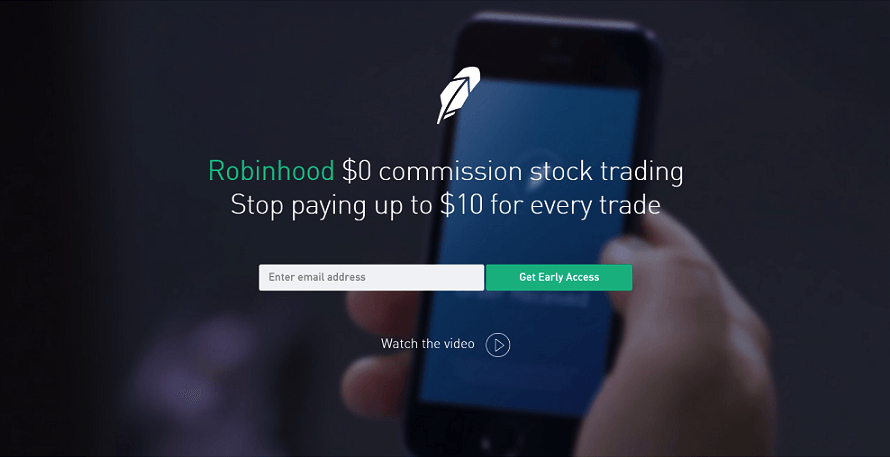
Robinhood gained more than 1 million subscribers before it even launched through people simply sharing one landing page around. Since then, the platform has grown exponentially, with multiple funding rounds, and has become the millennial investing application.
TikTok
TikTok's success with growth marketing is a great example of how influencer marketing and creative marketing tactics can help businesses achieve rapid growth and establish themselves as leading player in their industry.
TikTok's marketing strategy focused on
partnering with influencers who had a large following on social media platforms like Instagram and
YouTube. These influencers would create videos on TikTok and share them with their followers on other platforms, helping to drive awareness and user acquisition for the app.
They also used a range of creative marketing tactics to build buzz around the platform, including the #InMyFeelings challenge (you probably heard of it), which quickly went
viral and helped to drive a surge in user acquisition for the app.

Spotify
By entering a highly competitive music industry with a different approach,
Spotify disrupted the market by offering unlimited music for a low monthly fee. They allowed users to control their music choices and create personalized soundtracks, which many were willing to pay for.
Spotify also used a freemium model, which delicately placed ads and limited features without upsetting users or being classified as pirating. The company beta launched and officially launched in multiple European countries before entering the US market, which helped them to hone their message and target buyer personas.
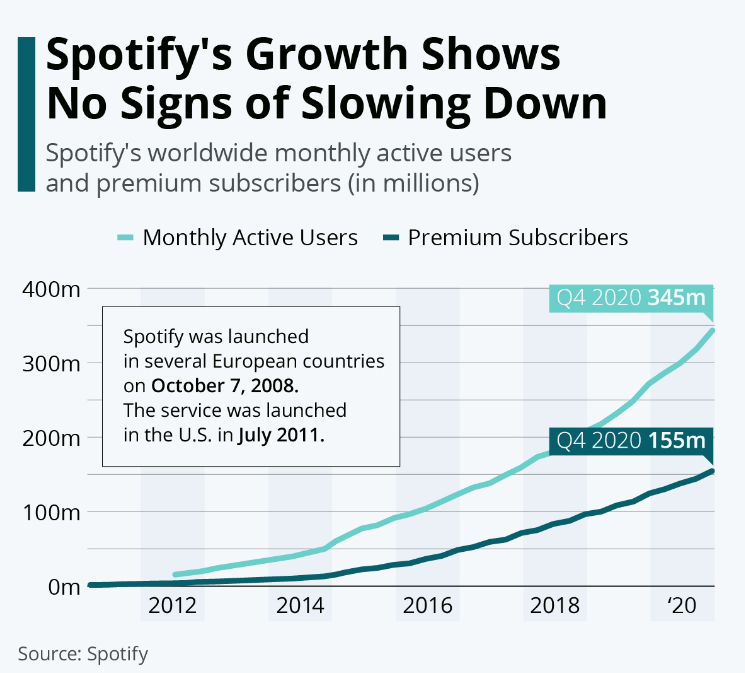
Spotify integrated with Facebook in a solid partnership that led to 1 million new users within a month.
Through a combination of differentiation, delivering goods, a freemium model, multiple launches, and partnering with Facebook, Spotify achieved explosive growth and continues to dominate the music streaming industry with over 406 million users and a market cap of more than $20 billion.
HubSpot
HubSpot is a company that has become well-known for its practice of inbound marketing. This approach has helped them to achieve rapid growth, even with high-dollar products. How did they manage this?
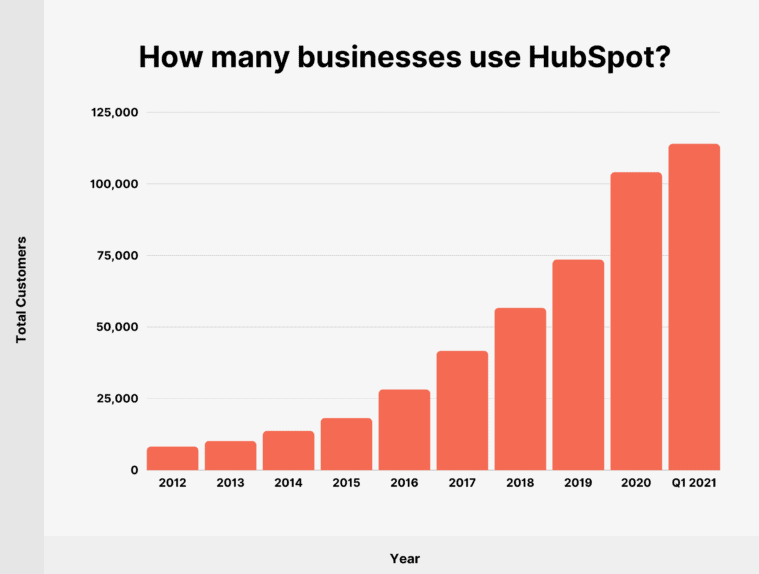
HubSpot has one of the most valuable online presences in the world of sales and marketing. It is born out of years of authority building and dominating search engine results pages (SERPs) with an ultra-effective content strategy and SEO.
In addition to that, HubSpot provides a lot of value for free. Free guides, courses, templates, and other resources to help people learn more about marketing. This has earned them fans, leads, and exposure, especially when matched with tailored calls-to-action that increase conversions and growth.
What are some challenges to overcome in implementing a growth marketing plan?
Executing a growth marketing strategy comes with some perils. It is never always a smooth ride. Some common challenges you should prepare to surmount are:
1. Limited resources
There’s hardly enough to fund all the initiatives of your growth marketing plan. Securing the budget you need will almost always be a pressing challenge, especially in smaller organizations. To overcome this, you must prove the ROI of your marketing efforts by spending money on the high-performing initiatives already validated by data.
2. Revenue attribution issues
In 2022,
21% of marketers said they expect tracking the ROI of their marketing activities to be their biggest issue. However, effective analytics and measurement can help attribute revenue to your growth campaigns. A stronger relationship with sales is also essential to link marketing activities to sales results.
3. Rapidly changing landscape
In the constantly changing landscape of growth marketing, there’s no time to kick back and watch the results roll in. Old strategies eventually stop working. You must refine your strategies on a regular basis and prioritize customer relationships to discover new opportunities.
Also, conducting a skills gap analysis and implementing
growth marketing training programs can also help identify strengths and weaknesses in your marketing team. The best growth marketers cultivate a constant state of learning to stay on top of industry trends and adapt quickly.
Recap
In this definitive guide to growth marketing, we’ve covered what growth marketing means, how it stands out from other types of marketing, examples of growth marketing frameworks, and growth marketing strategies.
We illustrated the successful execution of growth marketing campaigns with real-world examples from companies such as Robinhood and HubSpot. And then we guided you through some best practices.
Ultimately, we’ve shown you that growth marketing requires a repeatable practice of identifying opportunities, creating hypotheses, experimenting, scaling, and analyzing results. This works best when you identify your North Star metric, and track other key metrics to achieve your business growth goals.










